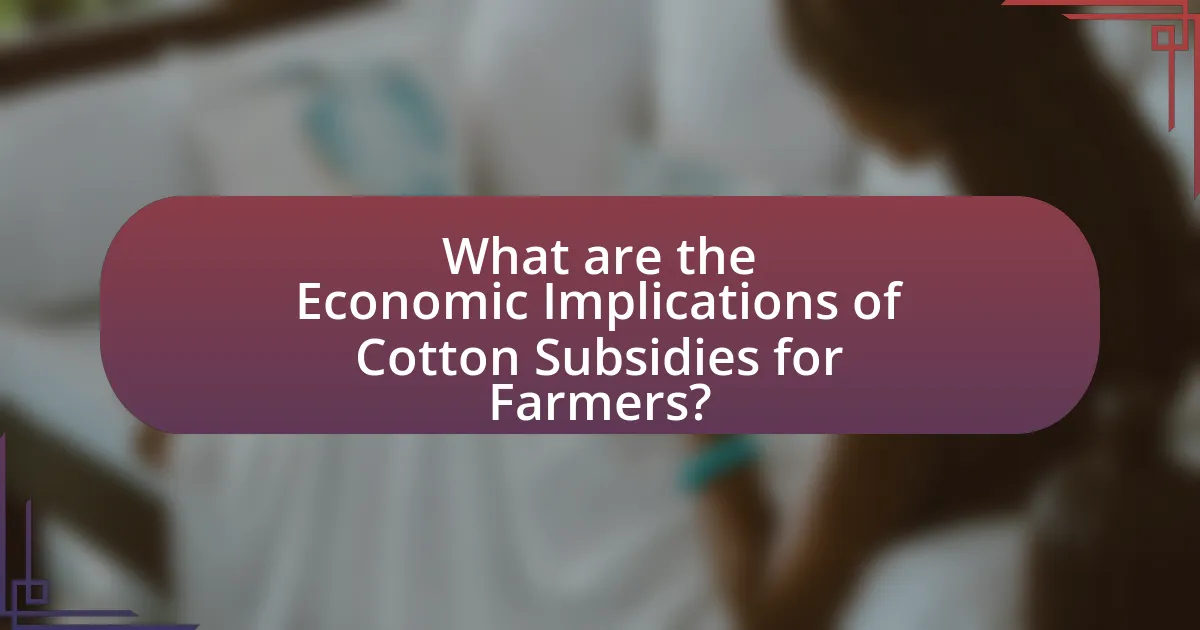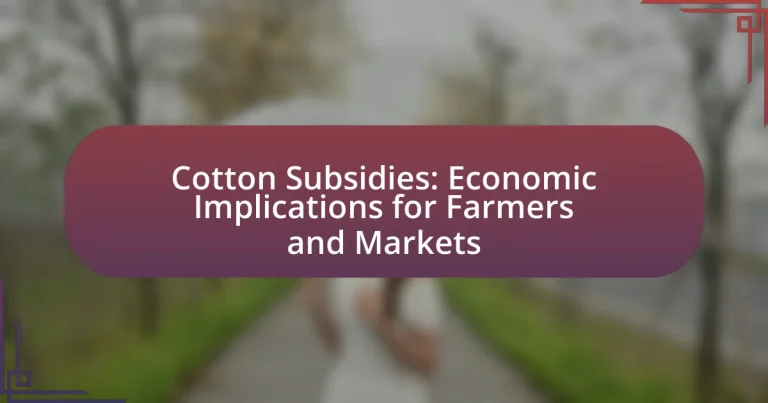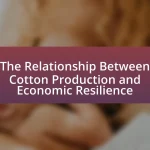Cotton subsidies are government financial assistance programs designed to support cotton farmers and stabilize the cotton market. This article examines the various forms of cotton subsidies, including direct payments, price supports, and crop insurance, and their impact on agricultural markets. It explores how these subsidies function to stabilize farmer income, influence production levels, and affect international trade dynamics. Additionally, the article discusses the economic implications for farmers, including the benefits and challenges of reliance on subsidies, their effects on market prices, competition among producers, and the potential for innovation in farming practices.

What are Cotton Subsidies?
Cotton subsidies are financial assistance programs provided by governments to support cotton farmers and stabilize the cotton market. These subsidies can take various forms, including direct payments, price supports, and tax breaks, aimed at reducing production costs and ensuring farmers receive a minimum income. For instance, in the United States, the cotton industry has historically benefited from subsidies that have amounted to billions of dollars, significantly influencing global cotton prices and trade dynamics.
How do Cotton Subsidies function in agricultural markets?
Cotton subsidies function in agricultural markets by providing financial support to cotton farmers, which helps stabilize their income and encourages production. These subsidies can take various forms, including direct payments, price supports, and crop insurance, aimed at reducing the financial risks associated with fluctuating market prices. For instance, in the United States, the government has historically implemented programs like the Cotton Price Support Program, which guarantees a minimum price for cotton, thus ensuring that farmers receive a stable income even when market prices fall. This intervention can lead to increased cotton production, impacting supply levels and market prices. According to the USDA, cotton subsidies have contributed to the U.S. being one of the largest cotton producers globally, with the 2021 cotton production valued at approximately $5.5 billion.
What are the key components of Cotton Subsidies?
The key components of cotton subsidies include direct payments to farmers, price support mechanisms, and crop insurance programs. Direct payments provide financial assistance to cotton producers, ensuring a stable income regardless of market fluctuations. Price support mechanisms, such as minimum price guarantees, help maintain cotton prices above market levels, protecting farmers from volatile price drops. Crop insurance programs offer risk management by compensating farmers for losses due to adverse weather or market conditions. These components collectively aim to stabilize the cotton industry, enhance farmer income, and promote agricultural sustainability.
How do Cotton Subsidies impact production levels?
Cotton subsidies significantly increase production levels by providing financial support to farmers, which incentivizes them to cultivate more cotton. This financial assistance lowers the cost of production, allowing farmers to invest in better seeds, technology, and farming practices. For instance, in the United States, cotton subsidies have historically led to increased acreage planted with cotton, contributing to a production increase of over 50% from the 1990s to the early 2000s. Additionally, according to the USDA, these subsidies can stabilize farmers’ incomes, encouraging them to maintain or expand their cotton production even in fluctuating market conditions.
Why are Cotton Subsidies implemented by governments?
Cotton subsidies are implemented by governments to support domestic cotton farmers and stabilize the agricultural economy. These subsidies help ensure that farmers can maintain their livelihoods despite fluctuations in market prices, which can be volatile due to factors like weather conditions and global competition. For instance, in the United States, the government has provided substantial subsidies to cotton farmers, amounting to over $3 billion annually, to protect them from price drops and to encourage production. This financial assistance aims to promote agricultural sustainability and food security while also maintaining the competitiveness of domestic cotton in the global market.
What economic goals do Cotton Subsidies aim to achieve?
Cotton subsidies aim to achieve economic stability for cotton farmers and enhance the competitiveness of the cotton industry. These subsidies provide financial support that helps farmers manage production costs, stabilize their income, and mitigate the risks associated with market fluctuations. For instance, in the United States, cotton subsidies have historically contributed to maintaining a stable supply of cotton, which is crucial for both domestic and international markets. According to the U.S. Department of Agriculture, these subsidies have allowed farmers to remain viable despite price volatility, ensuring a consistent production level that supports related industries and employment.
How do Cotton Subsidies affect international trade?
Cotton subsidies significantly distort international trade by artificially lowering the price of domestically produced cotton in subsidizing countries. This price reduction enables these countries to export cotton at lower rates, undermining the competitiveness of cotton producers in non-subsidizing countries. For instance, the United States, which provides substantial cotton subsidies, has been reported to export cotton at prices that are often below the cost of production for farmers in developing nations, leading to trade imbalances and economic challenges for those producers. According to the World Trade Organization, such subsidies can lead to retaliatory measures and trade disputes, further complicating international trade dynamics.

What are the Economic Implications of Cotton Subsidies for Farmers?
Cotton subsidies significantly impact farmers’ economic stability by providing financial support that can enhance their income and reduce production costs. These subsidies enable farmers to invest in better technology and practices, leading to increased yields and profitability. For instance, in the United States, cotton subsidies have historically accounted for a substantial portion of farmers’ income, with reports indicating that they contributed over $3 billion annually in recent years. This financial assistance can also stabilize market prices, allowing farmers to plan their production more effectively. However, reliance on subsidies can create market distortions, leading to overproduction and potential long-term dependency on government support, which may hinder sustainable agricultural practices.
How do Cotton Subsidies influence farmer income?
Cotton subsidies significantly increase farmer income by providing financial support that stabilizes prices and reduces production costs. These subsidies enable farmers to invest in better technology and practices, leading to higher yields. For instance, in the United States, cotton subsidies have historically accounted for a substantial portion of farmers’ income, with reports indicating that they can cover up to 50% of production costs. This financial assistance helps farmers remain competitive in the global market, ensuring their economic viability and encouraging continued investment in cotton production.
What are the short-term benefits for farmers receiving subsidies?
Farmers receiving subsidies experience immediate financial relief, which enhances their cash flow and allows for investment in essential resources. This financial support can lead to increased production capacity, enabling farmers to purchase seeds, fertilizers, and equipment necessary for cotton cultivation. Additionally, subsidies can stabilize market prices, reducing the risk of income volatility due to fluctuating market conditions. For instance, in the United States, cotton subsidies have historically helped maintain farmers’ income levels, even during periods of low market prices, thus ensuring their economic viability in the short term.
How do Cotton Subsidies affect long-term sustainability for farmers?
Cotton subsidies negatively affect long-term sustainability for farmers by encouraging over-reliance on government support and promoting unsustainable farming practices. These subsidies can lead to increased production levels that exceed market demand, resulting in lower prices and reduced profitability for farmers in the long run. For instance, a study by the International Cotton Advisory Committee found that countries with high subsidy levels often experience market distortions, which can undermine the economic viability of cotton farming. Additionally, reliance on subsidies can deter farmers from investing in sustainable practices, such as crop diversification and soil health improvements, ultimately compromising their long-term productivity and environmental stewardship.
What challenges do farmers face with Cotton Subsidies?
Farmers face several challenges with cotton subsidies, primarily including dependency on government support, market distortion, and compliance with regulations. Dependency on subsidies can lead to reduced motivation for farmers to innovate or improve efficiency, as they may rely on financial assistance rather than developing sustainable practices. Market distortion occurs when subsidies artificially lower prices, making it difficult for farmers to compete in a global market where other countries may not provide similar support. Additionally, compliance with complex regulations tied to subsidies can impose administrative burdens on farmers, diverting their focus from production to paperwork. These challenges can ultimately affect the long-term viability of cotton farming and the economic stability of rural communities.
How do market fluctuations impact the effectiveness of Cotton Subsidies?
Market fluctuations significantly reduce the effectiveness of cotton subsidies by altering the price dynamics of cotton. When market prices for cotton rise, subsidies may become less impactful as farmers benefit from higher revenues without reliance on government support. Conversely, when prices fall, subsidies are crucial for maintaining farmers’ income, but they may not fully compensate for the loss, leading to financial strain. For instance, during the 2014-2015 period, a decline in global cotton prices by over 30% diminished the effectiveness of subsidies in stabilizing farmer incomes, highlighting the direct correlation between market conditions and subsidy utility.
What are the risks of dependency on Cotton Subsidies?
Dependency on cotton subsidies poses several risks, including market distortion, reduced competitiveness, and environmental degradation. Market distortion occurs as subsidies can lead to overproduction, causing prices to drop and harming farmers who do not receive subsidies. This was evident in the United States, where cotton subsidies contributed to a significant surplus, impacting global cotton prices. Reduced competitiveness arises when farmers rely on subsidies rather than improving efficiency or diversifying crops, which can leave them vulnerable to market fluctuations. Additionally, the reliance on cotton subsidies can encourage practices that harm the environment, such as monoculture farming, which depletes soil health and biodiversity. These risks highlight the potential negative consequences of sustained dependency on cotton subsidies for farmers and markets.

How do Cotton Subsidies affect Market Dynamics?
Cotton subsidies significantly distort market dynamics by artificially lowering the price of cotton, which impacts both domestic and international markets. These subsidies enable farmers to produce cotton at lower costs, leading to increased supply in the market. For instance, in the United States, cotton subsidies have historically allowed American farmers to sell cotton at prices below the global market rate, which can undermine farmers in countries without similar support. According to the World Trade Organization, U.S. cotton subsidies were estimated to be around $3 billion annually, contributing to overproduction and price suppression in global markets. This results in a competitive disadvantage for farmers in developing nations, affecting their livelihoods and market stability.
What is the relationship between Cotton Subsidies and market prices?
Cotton subsidies directly influence market prices by artificially lowering production costs for farmers, which can lead to increased supply in the market. When governments provide financial support to cotton producers, it enables them to sell their products at lower prices than they would without subsidies. This increased supply can result in a decrease in market prices, as seen in various studies, including the 2018 report by the Food and Agriculture Organization, which indicated that subsidies in major cotton-producing countries led to price distortions in global markets. Consequently, while subsidies aim to support farmers, they can create an oversupply situation that depresses market prices, affecting both domestic and international cotton markets.
How do subsidies influence supply and demand in the cotton market?
Subsidies increase the supply of cotton by lowering production costs for farmers, which encourages them to produce more. When farmers receive financial support, they can afford to cultivate larger areas and invest in better technology, leading to higher output levels. For instance, in the United States, cotton subsidies have historically allowed farmers to maintain production even when market prices are low, resulting in an oversupply in some years. This increased supply can lead to lower market prices, affecting demand as consumers may purchase more cotton products when prices decrease. Additionally, subsidies can distort market equilibrium by creating a reliance on government support, which can lead to inefficiencies in resource allocation within the cotton market.
What role do Cotton Subsidies play in price stabilization?
Cotton subsidies play a crucial role in price stabilization by providing financial support to cotton farmers, which helps maintain consistent production levels and market prices. These subsidies reduce the financial risk associated with fluctuating market prices, enabling farmers to invest in their operations and produce cotton even during periods of low market prices. For instance, in the United States, the cotton subsidy program has historically included direct payments and price support mechanisms, which have contributed to a more stable income for farmers and reduced the volatility of cotton prices in the global market. This stabilization is essential for both producers and consumers, as it ensures a reliable supply of cotton while preventing drastic price swings that could disrupt the market.
How do Cotton Subsidies impact competition among farmers?
Cotton subsidies reduce competition among farmers by providing financial support that allows subsidized farmers to sell their cotton at lower prices than non-subsidized farmers. This price advantage can lead to market distortions, where subsidized farmers dominate the market, making it difficult for unsubsidized farmers to compete effectively. For instance, in the United States, cotton subsidies have been shown to lower the market price of cotton, which can push unsubsidized farmers out of the market, as evidenced by a study from the International Food Policy Research Institute indicating that U.S. cotton subsidies significantly affect global cotton prices and competitiveness.
What are the effects of subsidies on small vs. large cotton producers?
Subsidies have a disproportionate effect on small versus large cotton producers, primarily benefiting larger producers. Large cotton producers often receive a greater share of subsidies due to their capacity to produce at scale and their established relationships with government programs. For instance, in the United States, data from the Environmental Working Group indicates that between 1995 and 2019, the top 10% of cotton producers received over 70% of total cotton subsidies, highlighting the concentration of benefits among larger farms.
In contrast, small cotton producers typically struggle to access these subsidies due to bureaucratic hurdles and limited resources, which can exacerbate existing inequalities in the agricultural sector. Research from the International Food Policy Research Institute shows that smallholders often lack the necessary capital and knowledge to navigate subsidy applications effectively, resulting in lower overall financial support compared to their larger counterparts. This disparity can lead to reduced competitiveness for small producers, ultimately affecting their sustainability and market presence.
How do Cotton Subsidies influence innovation in farming practices?
Cotton subsidies significantly influence innovation in farming practices by providing financial support that encourages farmers to adopt new technologies and methods. These subsidies reduce the financial risk associated with investing in innovative practices, such as precision agriculture, genetically modified seeds, and sustainable farming techniques. For instance, a study by the National Cotton Council found that farmers receiving subsidies were more likely to invest in advanced irrigation systems and pest management technologies, leading to increased yields and reduced environmental impact. This financial backing thus acts as a catalyst for innovation, enabling farmers to enhance productivity and sustainability in cotton farming.
What are the best practices for farmers navigating Cotton Subsidies?
Farmers navigating cotton subsidies should first understand the specific subsidy programs available to them, such as the Cotton Price Support Program and the Direct Payments Program. Familiarity with these programs allows farmers to maximize their benefits. Additionally, farmers should maintain accurate records of their production costs and yields, as this data is essential for applying for subsidies and ensuring compliance with program requirements. Engaging with local agricultural extension services can provide valuable insights and updates on subsidy changes and eligibility criteria. Furthermore, farmers should consider diversifying their crops to mitigate risks associated with reliance on cotton subsidies, as fluctuations in market prices can impact their overall income. Lastly, staying informed about policy changes at both state and federal levels is crucial, as these can directly affect subsidy availability and amounts.





